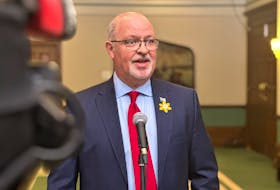
Economist Wade Locke was contracted as an advisor to Finance Minister Jerome Kennedy for the development of Budget 2013.
While there was no formal report required as part of his contract, Locke did issue a six-page, final memo to the minister on the province’s economy, the new 10-year sustainability plan and what the economist — also an economics professor at Memorial University of Newfoundland — sees as important considerations for Newfoundland and Labrador’s financial future.
The Locke memo was mentioned by Kennedy to reporters on Tuesday, before he delivered his budget speech.
It has since been provided to The Telegram. The complete memo is provided here.
In the memo, Locke walks through the problem with using terms like “have province” and the importance of provincial taxpayers understanding the basic reality of the province’s financial situation.
He refers to the provincial government’s 10-year sustainability plan for budgeting as “balanced” and “flexible,” repeatedly highlighting the importance of the latter, considering the changes that might come politically and economically over time.
“The plan is evolutionary, or more specifically, it is a living document,” he writes.
Adjusting within the framework of a general plan is better approach than making changes and cuts without any high-level guide, Locke suggests.
“You can hope that things work out as planned or hope that they work out as you would prefer, but hope is neither a strategy or a plan,” he states.
He calls upon government to keep watch on the net debt. The interest costs for servicing your debt is money otherwise spent on public services, and capital projects.
“Although only nine per cent of current revenue are absorbed by debt servicing, in the recent past this was as high as 25 per cent,” he states.
“That is, one in every four dollars collected by government was going to service the debt ... If we are not careful in controlling our debt, we could easily get back to that level and higher,” he writes.
“If that were to take place, this (cost-cutting) exercise would have been a stop-gap measure that would have been only temporary. It would have to be repeated again in the near future.”
Under the umbrella of debt servicing, Locke flagged unfunded pension liabilities as a main concern.
“Since 64 per cent of the provincial net debt comes from the unfunded pension liabilities and from the post-retirement benefits liabilities and this figure is both the fastest growing component of net debt and is expected to increase in the future if no action is taken, then it is a crucial part of any fiscal sustainability plan that these issues be addressed,” Locke states.
Locke spoke with The Telegram about the budget following its release Tuesday (http://www.thetelegram.com/Business/2013-03-27/article-3208445/Unexpected-oil-revenues-help-with-deficit/1), conveying much of what was included in his memo to government.
Complete Memo Below
March 25, 2013
To: Minister Jerome Kennedy, Department of Finance, Government of Newfoundland and Labrador
From: Dr. Wade Locke, Senior Policy Advisor to the Minister of Finance and Full Professor of Economics, Memorial University
Subject: Comments and Clarification on the Sustainability Plan
While I appreciate that no written report was required as part of my contract with the Department of Finance to provide advice to you on the development of your fiscal sustainability plan, I feel it is important to emphasize, and to put in writing, the following points which are in addition to the ongoing advice that I have been providing as your plan developed and evolved. These comments can be summarized as relating to:
1. the possibility of a province being designated as a “have” or “equalization-non-receiving” province, while simultaneously being a province which is characterized by a fiscal problem that requires a fiscal sustainability plan;
2. the balance, flexibility and specificity achieved within the fiscal sustainability plan;
3. the level and timing of the deficit and debt targets;
4. the balance between taxation increases and spending reductions in achieving the debt and deficit targets in both the short and longer runs;
5. the oil prices assumed in the sustainability plan;
6. the issues around the volatility of oil production and the implication of this volatility for fiscal sustainability planning;
7. the interaction of unfunded pension/retirement benefit liabilities and debt reduction and its implication for the fiscal sustainability plan; and
8. an overall assessment of the fiscal sustainability plan.
1. Can a “Have” Province Have a Fiscal Problem — It appears to be misunderstood by many what it means to be a “have” province under the equalization program. It is really unfortunate that the phase “have” provinces has been utilized, since the equalization program began in the 1950s, to refer to “equalization non-receiving” provinces. If it had been the convention to describe provinces as either equalization-receiving or as equalization-non-receiving provinces, then much of the confusion around the possibility that a “have” province could have a fiscal problem which requires a fiscal sustainability plan may have disappeared.
Given the apparent confusion around this issue, I would suggest that you explain the difference between the two concepts as follows: an equalization-receiving province is one in which the average per capita revenue that it receives from its tax bases falls short of the national average per capita revenue received across all provinces and a non-receiving province is one in which its average per capita revenues exceed the national average. Alternatively, a province that is experiencing a fiscal problem is one where both its average per capita expenditures exceed its average per capita revenues and this situation is expected to prevail for a period of time unless some action is taken to raise revenues or reduce expenditures.
In this context, it is certainly possible for a province, like Newfoundland and Labrador, to have average per capita revenues, driven by resource revenues, that exceed the ten-province average, while simultaneously having average expenditures that exceed its average per capita revenues. Since the average per capita expenditures in Newfoundland and Labrador exceed the average ten-province per capita expenditures by 50% and its average per capita revenues exceed the Canadian average by less than 50%, the province would be considered a “have” province in terms of equalization, but it is also important to note that it would be a province that has a fiscal problem. This, in turn, requires the province to reduce its expenditures to a more manageable level that is in line with its revenue expectations. Hence, this rationalizes the need for a fiscal sustainability plan!
2. Balanced, Flexible and Possessing the Right Degree of Specificity – I think the plan is an excellent one in that, in my opinion, is balanced and flexible, while simultaneously having specific targets that are defined for a given time period. In particular, to ensure that fiscal discipline in the future, the plan specifies short-run, medium term and longer run targets and goals. The short-run goals are, for example, deficit reductions within the first two years; an operational efficiency review of the Regional Health Authorities; and a post-secondary education review. The medium-term objectives are to return to budgetary surplus within three years and to review pensions and post-retirement benefits. The long-run target is to bring the province’s net per capita debt gradually down to the all-province level within ten years. As well, the plan does recognize that in the current environment, which is characterized by volatility and uncertainty, it is important to maintain, as an option, the ability to alter the specific initiatives adopted in any given year and to not be locked into an arbitrary and mechanically-derived schedule for reducing deficits and debt.
The plan is evolutionary, or more specifically, it is a living document. The initiative contained therein will grow and evolve as information become known and circumstances in the future are manifested. In the presence of substantial uncertainty and imprecision—especially in terms of oil prices and production, it is an optimal strategy to indicate what you expect to undertake and the targets you plan to achieve over time, but to explicitly acknowledge as well that as circumstances change, you need the flexibility to modify your specific actions so as to tailor your initiatives to increase the likelihood of achieving the plan’s long-term goals. That is, the plan is built on the premise of flexibility and commitment without being mechanical or rigidly sticking to an arbitrarily determined schedule that, at any point in the future, may not be in the best interest of the people or the economy of the province. You can hope that things work out as planned or hope that they work out as you would prefer, but hope is neither a strategy nor a plan, which is why a flexible fiscal sustainability plan is needed.
I particularly like that the plan is balanced. It is a relatively easy and straightforward exercise to simply mechanically cut monies from the provincial budget, even the $1.5 and $1.6 billion budget deficits that were feared and envisioned when I starting providing advice to you and your officials on this plan. Anyone with a calculator or an excel spreadsheet could have reduced $7 billion to $5.5 billion either by a pro-rated cut across all departments or through specific cuts in particular departments that summed to $1.5 billion. The implied massive layoffs (in the thousands) would have been devastating for the people who work for government. They would not have had time to plan their transition from the public sector to the private sector and the adjustment costs would have been enormous. Moreover, the implications for the delivery of government services would have been significant, substantial and negative. It would have strained our ability to provide the essential public services that are fundamental to government’s role within society. Furthermore, the removal of this amount of spending from the economy within a short time period would have generated a recession in Newfoundland and Labrador. This would have been manifested in reduced business and consumer confidence; a depressed housing market —both in terms of prices and housing starts, postponed or significantly reduced new car and trucks sales.
While the fiscal circumstances improved since the pre-budget releases, I think the sensitivity exercised in addressing your fiscal problem over a period of time without imposing undue hardship on the majority of public sector workers and creating problems for the delivery of public services is a good one. The hiring freeze, the MHA wage freeze, the gradual layoff of temporary employees, the early retirement package, the core mandate analysis, the effective communication of the seriousness of the fiscal problem faced, the efficiency reviews to be undertaken next year and the commitment to address the unfunded pension and retirement liabilities through working with the unions to find an approach to pensions and benefits constitute what, in my opinion, is an optimal and balanced strategy for the current economic environment. In particular, this strategy, while it may have created anxiety for some in the public sector, has also allowed people to become acclimatized to the new fiscal realities and to plan with sufficient advance notice, which, in turn, should mitigate the corresponding adjustments costs that accompany any change.
In terms of balance, it is always important to appreciate that cuts to expenditures are more than just numbers on a spreadsheet, they impact real people in terms of employment or through the delivery of services to which they have become accustomed. However, doing nothing is not an option because of the implications for net debt and debt servicing which will eliminate our discretion in the future as interest costs make up an increasing portion of the public expenditure. Consequently, this would reduce our ability to fund essential public services and to fund them utilizing reasonable and competitive rates of taxation.
3. The Right Deficit and Debt Targets over the Right Time Frame —As I noted above, it is important that you set a 10-year target to bring the province’s finances in line with a net debt per capita target that matched the all-province average net debt per capita. This ensures that interest costs from debt servicing do not crowd out too much expenditure that would otherwise be available for essential public services. Although only 9% of current revenue are absorbed by debt servicing, in the recent past this was as high as 25%. That is, one in every four dollars collected by government was going to service the debt and was not available for health care, education, roads, social services, etc. If we are not careful in controlling our debt, we could easily get back to that level and higher. This, in turn, would imply that Newfoundlanders and Labradorians receive less public services, significantly higher taxes or a combination of higher taxes and less services and correspondingly, this would result in lower standards of living and wellbeing for current and future generations of Newfoundlanders and Labradorians.
In my opinion, the 10-year net debt reduction target is feasible. It imposes a fiscal discipline on the government that requires the generation of surpluses that will be allocated in part to strategic and necessary infrastructure investments with the residual surpluses applied to reducing net debt per capita to the all-province average within 10 years.
It is also important to recognize that when surpluses start to manifest themselves again in three years, as they are expected to under this plan, it will be relatively easy to slip into a “big spending” mentality. If that were to take place, this exercise would have been a stop-gap measure that would have been only temporary. It would have to be repeated again in the near future. Obviously, it is not in anyone’s interest to have a cycle of fiscal crises that entail larger and larger adjustment costs in the future. We need to get to a sustainable level of net debt and expenditure per capita and we need to get there in a gradual and planned way. Moreover, it is not in the province’s interest to move to this target too quickly because the adjustment costs to the economy will be larger and more negative than necessary.
Although having the ability and the time to plan for an outcome, may not prevent the outcome from happening, but it can certainly reduce the adjustment costs associated with it. If a person is going to lose their job and they know it in advance, then with sufficient time, they can find another job, plan to retire from the workforce, retrain for another career, or relocate to a jurisdiction where a job is available. These options are more likely to be effective when the individuals have had time to adjust, rather than having to react instantaneously to a set of circumstances that have been thrust upon them. In other words, implicit in your plan is the assumption that planning is better than reacting, a concept that is consistent with my own personal philosophy.
4. Balancing Tax Increases, Expenditures Reductions and Time Frame in Meeting the Fiscal Sustainability Objectives — While some people have been advocating that you do not need to cut expenditures because you can raise personal income taxes on the rich (whoever they may be) and on major corporations (really the oil companies and mining companies operating within the province). As well, I have suggested to you that a 2% increase in the HST over a two-year period would be appropriate and desirable in the current environment where your neighbouring provinces are raising their own HST rates.
First, I will deal with my suggestion about the HST increase. While I understand that this is not a consideration in the current budget round, I would encourage you keep it in mind as a possible instrument that could be utilized in the future should circumstances warrant it. That is, this is a permanent revenue source (in the range of $200 million) that can help you reach your net debt targets in the future should circumstances require its implementation. I appreciate that fiscal situation has improved in terms of additional production and oil revenues in the short and medium terms, additional revenues in terms of mining taxes, sales tax adjustments, etc., which, in turn, implies that the sustainability plan can be met without having to resort to 2% being added to the HST. I also understand your reluctance to tamper with the improved tax competitiveness that Newfoundland and Labrador has achieved in recent years. By having an attractive fiscal environment (relatively low taxes), Newfoundland and Labrador both shares the benefits of resource-generated prosperity with all of the residents of the province, while simultaneously enhancing economic activity and growth, contributing to a diversified economy and enhanced future prosperity. Notwithstanding this, you should not completely rule out the possibility of utilizing the HST as an instrument to meet you long term fiscal targets should that become necessary in the future.
Second, let me deal with the individuals arguing that we should be raising taxes on the rich to reduce inequities in income distribution and stimulate growth. It should be recognized that there are not enough of the so-called rich to have a meaningful impact of provincial revenues. If you want to raise sufficient revenue with income taxes to have any kind of noticeable impact on your fiscal plan, then it will requiring taxing a lot of people who would not consider themselves part of the rich (i.e., the middle class).
As well, it is a peculiar perspective indeed that higher taxes will lead to higher growth. We typical teach the opposite in economics courses. I recognize that an income tax can have such an “income effect” on people that they are made so much poorer after taxes that their work effort increases. However, that is not likely the case for the majority of people who will work less when you tax away their incremental income. In other words, higher taxes will likely reduced work effort and economic growth, but, in any event, it will not stimulate it. Consequently, we will have a smaller base paying a higher share of the taxes, making Newfoundland and Labrador a less attractive place to live and establish businesses.
Third, while the idea of extracting greater revenues from “big oil” or “big mining” has a particular ideological appeal to a subset of the population who believe that these corporation, the owners of which do not live here, are under-taxed, one has to be careful that the fiscal regimes for mining and oil and gas are competitive with other jurisdictions. If our system is more onerous than our competitors, then we will have difficulty maintaining an industry. It is also important to note that these industries have been the driving forces behind the current prosperity that have generated huge revenue for government, facilitated weekly wages that exceed the Canadian average, created historic employment levels, instilled consumer and business confidence at unprecedented levels and created growth in the housing and new vehicle markets to levels never imagined previously.
We have to be very careful that we do not destroy the goose that laid the golden egg. Moreover, there is no evidence that fiscal regimes imposed on the resource sectors in Newfoundland and Labrador are inappropriately low, when risk, the size of capital investments, and prospectivity, are taken into account. Interestingly, we do not see long lines of resource companies beating down our doors to invest in the province. There is certainly a healthy investment that accompanies a competitive environment, but not the excessive amount that we would expect to observe if we were giving away our resources through a tax regime that was too low. We have to be very careful here. The fiscal regimes appear to be consistent with other jurisdictions that also face mobile capital investment. If there is a need to review the fiscal regimes in Newfoundland and Labrador, and I am not convinced that there is, then this should be done separately and not part of a process to develop a sustainable fiscal plan.
5. Picking Prudent Oil Prices for Planning Purposes —Given that we are in an era of excessively volatile oil prices and forecasts that change dramatically from month to month, one has to be cautious about the oil price chosen for the purposes of budgeting and, in turn, for utilization in a fiscal sustainability plan. While the $124/barrel price in last year’s budget turned out to be too high in relation to the actual price that prevailed, the issue of oil prices and forecasts goes well beyond decisions made in any given year. It is important for planning purposes to pick a price that is neither too high nor too low. A price that is too high will likely generate optimistic estimates for royalties and oil-related corporation income taxes tax cannot be met in reality. The consequence of this is that the realized deficit will be larger than estimated at budget time. This will influence people’s perception of the credibility of the sustainability plan and reduce their acceptance and buy-in of meeting the long-term debt target. On the other hand, choosing a price that is too low will result in a deficit that is smaller than expected or a surplus when none was expected. This will have similar ramifications for the credibility of the sustainability plan and buy-in. In addition, it will open you up to the criticism that the number was chosen for political reasons pertaining to bargaining ̶―the perception would be that the price estimate was deliberately lowballed in order to create a fear that circumstances are dire to mitigate wage expectations. Another more serious issue is that a low price would imply larger expenditure cuts than needed to meet the long-term goals of the fiscal sustainability plan. Therefore, using the balance approach of the average of a number of forecasts avoids the likelihood of an outlier, either too high or too low, having undue influence on the fiscal sustainability plan. Finally, the choice of $105 per barrel is a good and prudent one given the information that is currently at your disposal.
6. Volatility in Oil Production, Another Constraint to Overcome —There has been considerable variation the pre and post budget estimates for levels of oil production on annual basis In some years, this variation are been as much as 24 million barrels. Depending on where the additional oil comes from, this can throw your forecast off by as much as $30 million dollars for each 1 million barrel change in production. While production will be whatever it is, just as prices are beyond your control, I feel that the commitment between the CNLOPB and the Government of Newfoundland and Labrador to strengthen the forecast and align the CNLOPB release dates with your budgetary cycle should help reduce some of the uncertainty around forecasting revenues. This should also help keep the fiscal plan on track to meet your sustainable expenditure plan and your ten-year debt reduction plan.
7. Unfunded Liabilities and Debt Reduction, Getting it Right is Crucial to a Fiscal Sustainability Plan – Since 64% of the provincial net debt comes from the unfunded pension liabilities and from the post-retirement benefits liabilities and this figure is both the fastest growing component of net debt and is expected to increase in the future if no action is taken, then it is a crucial part of any fiscal sustainability plan that these issues be addressed. It is imperative that a solution be found and the fact that you have initiated a pension review and will be working with the unions and other stakeholders to map out a options for reform in the near term is a good first step in developing an appropriate fiscal sustainability plan.
8. Overall Assessment, Minimizing the Maximum Damage, While Setting a Sustainable Course for the Future —The fiscal sustainability plan, in my opinion, is feasible. It has sufficient flexibility and specific targets built into the plan as to ensure that appropriate degree of fiscal discipline will be maintained without imposing undue adjustment costs on the people of Newfoundland and Labrador. It is a good plan for the economic times in which we now find ourselves.








